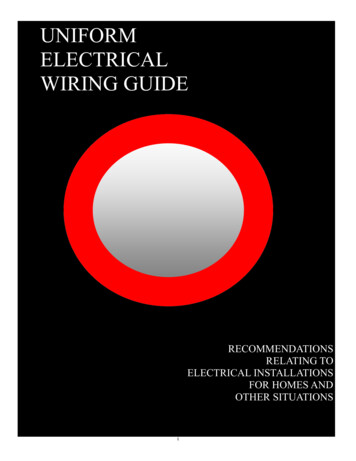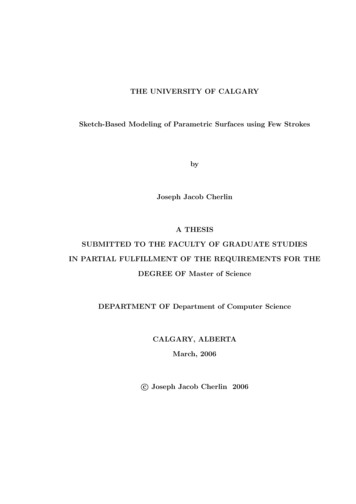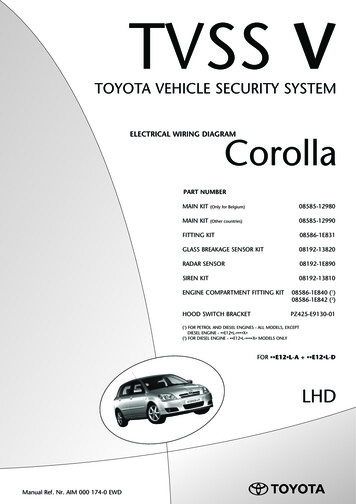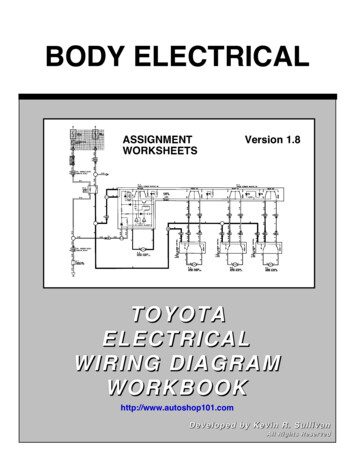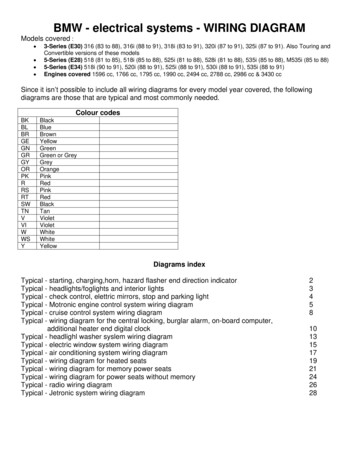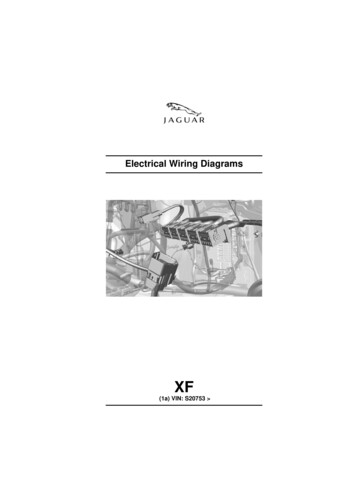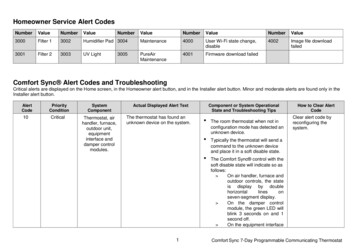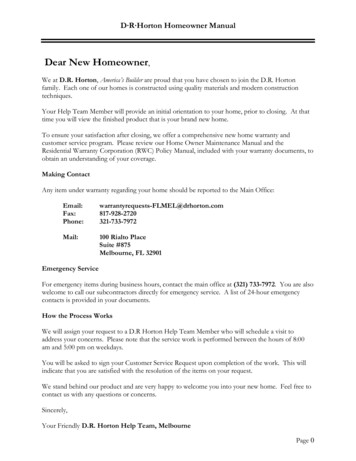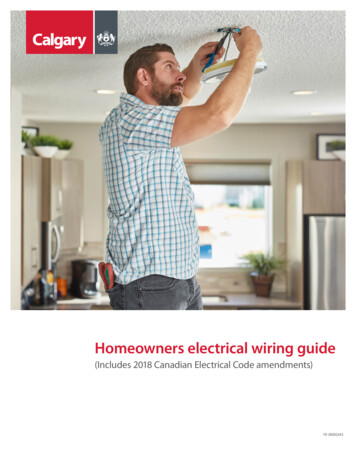
Transcription
Homeowners electrical wiring guide(Includes 2018 Canadian Electrical Code amendments)19-0000243
Table of contentsRequired inspections . 4Rough inspections (all work not visible for final inspection).4Final inspection (electrical complete).4Possible Outcomes.4Panelboards (service and sub-panels). 5Non-metallic sheathed cable (NMD90) and Armoured cable (AC-90) branch circuit wiring .5Fittings, devices and junction boxes .6Lighting and fixtures . 7Receptacles (outlets) . 8Branch Circuit wiring requirement . 9Ground fault protection (GFCI).9Arc-fault protection . 10Legacy panel, armoured cable. 11Underground installations . 12Quick Reference for various installations. 13Use of approved electrical equipment . 13Typical outlet. 14Three-way wiring configuration. 15In-floor heating raceway requirements. 162
Homeowner electrical wiring guide(Includes 2018 Canadian Electrical Code amendments)This document is only a guide. Other methods of installationmay be acceptable, but must meet the minimum requirements ofthe current Canadian Electrical Code.Homeowners obtaining an electrical permit are required to have a basicknowledge of electrical wiring.Homeowners are not permitted to: install, alter or modify the main electrical service, including the main panel,main breaker or the meter base.install electrical wiring in permanent, in-ground swimming pools and hot tubs.install or alter solar photovoltaic systems.Find more information on our website calgary.ca/myhomeTo connect with us contact our Technical Assistance Centre by calling us at 311This information has no legal status and cannot be used as an official interpretation of the various bylaws, codes and regulations currently in effect.The City of Calgary accepts no responsibility to persons relying solely on this information. This document is updated periodically.3
Required inspectionsHomeowner permits may require a minimum of two inspections, rough and final. Homeowner Electrical permits may be scheduled through 311 online services (calgary.ca/311online) orthrough the Calgary 311 app – Inspection – Electrical.Access must be arranged by the homeowner and someone 18 years or older must be present.Inspections will either be in the morning (between 8 a.m. and noon), or in the afternoon (between noonand 4:30 p.m.). You will receive a confirmation email the day of inspection. Inspections are conductedfrom Monday to Friday, excluding Holidays.If you wish to cancel your inspection, please call 311 and provide your electrical permit number and address.Note: The electrical inspection is separate from plumbing and building permit inspectionsRough inspections(all work not visible for final inspection) Have all wiring and interior of outlet boxes readily visible.Remove vapour barrier and insulation where it’s covering anywiring. The exception is for wiring fished into walls.All wiring must be supported.Remove outer sheath of wiring and terminate all wiring intooutlet boxes and fixtures.Ensure all splices are made and all grounding is complete inoutlet boxes and fixtures.Do not secure devices (plugs, switches) to outlet boxes.Leave all wiring and terminations visible.Cables may be terminated into the panelboard, but wiresshould not be terminated on breakers. Never energize exposed wiring. Rough and underground inspections should be combined. Expose the trench on at least one end to confirm depth. Access must be provided to all areas where electrical work hasbeen completed.For secondary suites, use the secondary suite electrical loadcalculation sheet to ensure your current electrical service isadequate. When complete, please email the form toelectrical.inspection@calgary.ca. If the main electrical servicemust be increased from 60 amps, 100 amps, or 200 - ampservice, please have your Contractor contact ENMAX atgetconnected@enmax.com.Final inspection(electrical complete) Access must be provided to all areas where electrical workhas been completed. Do not have any exposed live wiring. Install all devices, receptacles and light fixtures. Any open outlet boxes or unfinished wiring must be properlysecured and installed in a junction box with an approved splicecap and a junction box cover.Install, terminate and energize all breakers, if safe to do so.Complete the panelboard breaker directory, all breakers mustbe labeled correctly.A permit services report will be produced once all inspectionsare completed. The report summarizes inspection outcomesand explains the resulting permit condition(s). You can requesta report by logging into VISTA vista.calgary.ca or contactingthe Planning Services Centre calgary.ca/pdcontactPossible OutcomesThe Electrical Safety Codes Officer will advise of the inspectionoutcome. There are three possible outcomes: Acceptable: Continue with installation.Verification of compliance (VOC): Correct deficiencies andreturn a signed copy to electrical.TAC@calgary.ca – then youmay continue with the installation.Not acceptable: re-inspection will be required beforecontinuing with installation.This information has no legal status and cannot be used as an official interpretation of the various bylaws, codes and regulations currently in effect.The City of Calgary accepts no responsibility to persons relying solely on this information. This document is updated periodically.4
Panelboards (service and sub-panels)DO Have 1 m clearance with secure footing in front. Have adequate lighting. Have minimum headroom of 2.2 m. Identify all branch circuits to what they serve.DO NOT Put sub-panels in clothes closets, bathrooms orstairways.Have any breaker more than 1.7 m above thefloor.Relocate or change the main panelboard.Non-metallic sheathed cable (NMD90)and Armoured cable (AC-90) branchcircuit wiring Support cables with approved straps or stapleswithin 300 mm of an outlet box and at intervalsof 1.5 m thereafter.An approved mechanical protection plate isrequired where cables are: within 32 mm of the stud/joist face surface, orDrive staples asshown, within 300mm of connectorin boxsubject to damage from nails or screws wherelocated behind baseboards or cupboards.Exposed cables within 1.5 m of the floor requiremechanical protection.1.5 m Cables require a minimum separation of25 mm from heating ducts.Suggest mountingheight of outletbox is 300 - 400 mm orgreateterCommunication (TV, phone, speaker) cablesrequire a minimum separation of 50 mm frompower and lighting cables.Do not fish NMD90 cable into walls withmetal studs.NMD90 cable run through metal studs willrequire approved bushings or grommets,to protect the wire from sharp edges.Protector plateapproved for thespecific purposeA minimum 150 mm of conductor length isrequired in boxes240V loads such as electric heating, airconditioners, etc. should use NMD90 cableswith a red outer jacket.Less than 32 mmThis information has no legal status and cannot be used as an official interpretation of the various bylaws, codes and regulations currently in effect.The City of Calgary accepts no responsibility to persons relying solely on this information. This document is updated periodically.5
Fittings, devices and junction boxes Fasten all outlet boxes securely in place. Install all outlet boxes flush to the finished wall. Ceiling fan outlet boxes shall be marked forfan support. Unused openings in boxes and panels shall beclosed with approved covers. When used with lighting, vapour barriersmust be approved for 90 C.Hydro-massage bathtubs require removableaccess panels for maintenance.Support grouped outlet boxes and outlet boxesthat are greater than 100 mm on two sides.Cable boxes mounted on metal studs mustbe approved.The maximum number of conductors allowed in outlet boxes.** Where a box contains a dimmer switch or a GFCI outlet, deduct an additional wire for each.Box typeDimensionsHxWxDBox VolumeMillilitersNumber of #14 AWG wires(Black, white wires)Octagon(Light)4 x 1-1/2 deep245ml9 wires with 3 wire nuts3 x 2 x 2-1/8 deep344ml13 wires with 3 wire nuts3 x 2 x 2 deep163ml3 wires with 3 wire nuts and 1 device **3 x 2 x 2-1/2 deep204ml5 wires with 3 wire nuts and 1 device **3 x 2 x 3 deep245ml7 wires with 3 wire nuts and 1 device **2 gang 2-1/2 deep409ml11 wires with 3 wire nuts and 2 devices **2 gang 3” deep491ml15 wires with 3 wire nuts and 3 devices **3 gang 2-1/2 deep614ml18 wires with 3 wire nuts and 3 devices **4 x 1-1/2344ml14 wires. Deduct for wire nuts.4 x 2-1/8491ml20 wires. Deduct for wire nuts.Plug or switch(Device)Plug or switch(Device)This information has no legal status and cannot be used as an official interpretation of the various bylaws, codes and regulations currently in effect.The City of Calgary accepts no responsibility to persons relying solely on this information. This document is updated periodically.6
Lighting and fixturesBare light bulb Utility roomDo not install fixtures with a bare light bulbin closets.Protect light fixtures that are less than2.1 m high with a guard or by location. Bathtub/Shower stall Pot light Pot lights not marked “TYPE IC” must be atleast 13 mm from combustible materials and76 mm from insulation or in accordance withthe manufacturer’s instructions. You may be asked to remove a retrofit pot lightinstalled after the rough inspection, to verifythe installation.Three-way switch Three-way switching is required at the top andbottom of stairways with four or more stairs thatlead to a finished area or to an outside entrance.Utility room lights shall be controlled by awall switch at the entrance. Light switches must be more than 1 m awayhorizontally from a bathtub or shower stall.If not possible, they shall be at least 500 mmaway and protected by a Ground Fault CircuitInterrupter (GFCI).The furnace disconnect switch must be accessible.Often when a basement is developed, the existingswitch will need to be relocated (typically nearthe entrance to the utility room). This locationis for emergency purposes, so access to thefurnace disconnect switch must be reachablewithout passing the front of the furnace.A neutral (white) conductor shall be installedat every light switch outlet box.Branch CircuitNeutralconductorBranch CircuitBranch CircuitThis information has no legal status and cannot be used as an official interpretation of the various bylaws, codes and regulations currently in effect.The City of Calgary accepts no responsibility to persons relying solely on this information. This document is updated periodically.7
Receptacles (outlets) Any outlet installed within 2 m from thefloor must be tamper resistant.Bedroom Layout ExampleOutlets must be no more than 3.6 m apartin every open room and no more than1.8 m from a door or closet. Any wall space of900 mm or more in width requires an outlet.max. 1.8 mOutlets must be no more than 4.5 m apartin a hallway.max. 1.8 mWall length greater than 900mm requires receptacleNo more than 12 outlets shall be on abranch circuit.WindowIn order to be included in the minimum outletspacing requirements (shown in the diagram tothe right), outlets must be installed no higherthan 1.7m.max. 3.6 mmax. 3.6 mmax. 3.6 mKitchen Outlets must be no more than 1.8 m apartmeasured along the wall behind a counter top,and no more than 900 mm from a sink,stove or end point.Each fixed kitchen island or peninsula larger than600 mm x 300 mm requires at least one outlet(15A split or 20A T-slot).Each gas stove requires a 120V outlet notmore than 130 mm from the floor and as nearmidpoint as possible.A 14-50R stove outlet with #8 AWG wiremust not exceed 130 mm to the center fromthe floor and as near midpoint as possible,with the U ground slot at the side.Do not place outlets in a cupboard, cabinet orsimilar enclosure, except where the outletis for a specific type of appliance that is suitablefor installation within the enclosure(i.e. a microwave).Usable wall spaceUnusable wall spaceDuplex receptacleLaundry area Dryer outlets are type 14-30R with#10/3 AWG cables.Garage An outlet is required to be installed within1 m of a garage door opener.Each car space in a garage requires one outlet.Outdoor Bathroom/washroomEach laundry area requires an outlet,in addition to the washing machine.Outdoor outlets require covers approved forwet locations and must be marked extra duty.Install one outlet protected by a Class A GroundFault Circuit Interrupter (GFCI) within 1m of thebathroom or washroom wash basin.This information has no legal status and cannot be used as an official interpretation of the various bylaws, codes and regulations currently in effect.The City of Calgary accepts no responsibility to persons relying solely on this information. This document is updated periodically.8
Branch Circuit wiring requirementDO Have separate branch circuit for refrigeratorsand microwaves. Have electrical heat on a dedicated circuit. Have outdoor outlets on a separate circuit. DO NOTHave more than 12 outlets on a circuit. Have more than two kitchen outlets on a2 pole 15A circuit breaker or single pole 20Acircuit breaker. Install smoke and carbon monoxide alarms ona hard wired 120V circuit, with at least one light.These must not be on a circuit protected byArc fault or ground fault circuit interruptersunless equipped with an integral back up batterypower source. Only a Building Safety CodesOfficer can determine acceptable locations.Have at least one outlet on its own breaker forutility rooms.Have a separate circuit provided solely to supplypower to each central vacuum system.Ground fault protection (GFCI) 15A and 20A outlets installed within 1.5 m of asink, bathtub or shower must be GFCI protected.Exterior outlets within 2.5 m of finished grademust be GFCI protected (automotive heater andcharging outlets are exempt). Hydro-massage and hot tubs must be Class Aground fault protected.Ground fault circuit interrupters must be installedin a location that will facilitate testing. Theycannot be closer than 3 m to a hot tub and notcloser than 1.5 m to a hydro-massage bathtub. Light switches (including fan and heat controls)located between 500 mm and 1 m horizontallyfrom a sink, bathtub or shower stall shall beprotected by a GFCI.Heating devices (i.e. baseboard heater/towelwarmer) located less than 1.8 m above the floorand less than 1 m from a bathtub or shower stallshall be protected by a GFCI. Heating devicesshall not be located closer than 500 mm to abathtub or shower stall.A manually operated control (i.e. thermostat)for a heating device shall be permitted tobe less than 1m from a sink (wash basincomplete with a drainpipe) and not less than500mm from a tub or shower stall, providedthat it is protected by a ground fault circuitinterrupter of the Class A type or suppliedby an extra-low-voltage Class 2 circuit.This information has no legal status and cannot be used as an official interpretation of the various bylaws, codes and regulations currently in effect.The City of Calgary accepts no responsibility to persons relying solely on this information. This document is updated periodically.9
Arc-fault protectionAll branch circuits in a dwelling supplying 125V outlets rated 20A or less are to be protectedby a combination-type arc-fault circuit interrupter (AFCI).Only the following 15A or 20A outlets are excluded: Kitchen counter, island and peninsula outlets Kitchen refrigerator outlet A cord connected sump pump on a separate breaker (the sump pump must only be plugged intoa single receptacle and labeled sump pump use only)Non-metallic sheathedcable (NMD-90)OFFONOFFONOFFONOFFONOFFONOFFONCombination type arc-fault circut interrupterThis information has no legal status and cannot be used as an official interpretation of the various bylaws, codes and regulations currently in effect.The City of Calgary accepts no responsibility to persons relying solely on this information. This document is updated periodically.10
Legacy panel, armoured cableNon-metallic sheathedcable (NMD-90)Blank face deviceAmoured cable (AC90)OFFONOFFONOFFONOFFONOFFONOFFONStandard circuit breakerCircuit breakers are required to be approved for use in the panelboard in which they will be installed.Combination type AFCI breakers are not available for many older panelboards and the wiring methoddescribed below is required.The branch circuit wiring from the panelboard to the blank face device or first outlet must be armouredcable (AC90) or approved electrical tubing. This is to add additional protection to the branch circuit wiringwhere breakers are not used.Where combination AFCI breakers are not used, blank face protectors and outlets are permitted withsome restrictions.Each application has a preferred installation method based on level of protection and practicality.This information has no legal status and cannot be used as an official interpretation of the various bylaws, codes and regulations currently in effect.The City of Calgary accepts no responsibility to persons relying solely on this information. This document is updated periodically.11
Underground installationsClick before you dig: www.albertaonecall.com/homeownersDirect buried conductors, cables or raceways must be installed to meet the minimum cover requirements.Distance measured is between finished grade and top of conduit or cable.Wiring typeNon vehicle areasUnder vehicle trafficType NMWU direct buried **600mm900mmType NMWU in rigid PVC450mm600mmArmoured cable (TECK90)450mm600mm**Screened sand or screened backfill required.Cables or conductors installed underground in a PVC conduit must be acceptable for use inwet locations (NMD90 is not acceptable). Protect cables exiting from underground frommechanical damage by location or by rigidPVC conduit.Gas lines (i.e. house to garage) are thehomeowner’s responsibility. When electricalconductors are installed in the same trench,it is recommended that the two systems beseparated by 300 mm of well tamped soil or a50 mm treated plank.To house panelPVC Coupling To prevent damage to the conductors or theelectrical equipment, use a conduit expansionjoint where underground PVC conduits or cablescould be affected by settlement or frost.Do not place backfill containing large rock,paving materials, cinders, large or sharply angularsubstances or corrosive material where it maydamage or corrode cables or conduits andprevent adequate compaction of the soil.PVC LB Conduit450 mm (18”) belowgrade levelCable to sub-panelor first outlet boxNOTE: Other undergroundwiring methods are acceptedby the Canadian Electrical Code.NMD 90 cable is not acceptablefor underground installations.PVC 90 degree bendConduit to be continuous from house to garageThis information has no legal status and cannot be used as an official interpretation of the various bylaws, codes and regulations currently in effect.The City of Calgary accepts no responsibility to persons relying solely on this information. This document is updated periodically.12
Quick Reference for various installationsInstallation typeBreaker sizeCable sizeSize of conduit undergroundSingle circuit 120 Volt15 Amp14/2 NMWU3/ “4240 Volt - 30 Amp Sub panel2 pole 30 Amp10/3 NMWU1” (27mm) Rigid PVC240 Volt - 40 Amp Sub panel2 pole 40 Amp8/3 NMWU1-1/4 “ (35mm) Rigid PVC240 Volt - 60 Amp2 pole 60 Amp6/3 NMWU1-1/4” (35mm) Rigid PVC(21mm) Rigid PVCCAMERA-READY LOGOTYPE – UL MARK FOR CANADAThese Marks are registered by Underwriters Laboratories Inc.Use of approved electrical equipmentElectrical products and equipment must be approved by a Certification body, recognized by theStandards Council of Canada. Refer to the Alberta Electrical Safety STANDATA (LEG-ECR-2) found onthe Alberta Municipal Affairs website.Certificaton Mark ExamplesInspection Label ExamplesThe minimum height of the registered trademark symbol shall be 3/64 of an inch. When the overall diameter of theUL Mark is less than 3/8 of an inch, the trademark symbol may be omitted if it is not legible to the naked eye.The font for all letter forms is Helvetica Condensed Black, except for the trademark symbol , which isHelvetica Condensed Medium. No other fonts are acceptable.200-195B-20M/11/97This information has no legal status and cannot be used as an official interpretation of the various bylaws, codes and regulations currently in effect.The City of Calgary accepts no responsibility to persons relying solely on this information. This document is updated periodically.13
Typical outletWhite wire tosilver screwon receptacleFront edge tobe flush withfinished edgeGround wires go underthe box ground screws atthe back of the box andone continues to thereceptacle ground screw.Outer jacket 8 mm (1/4”)past internal clamp150 mm (6”) ofconductorPower inPower outPower in and outWhite wireBlack wireOctagon outlet boxWire connectorCopper wirePower to switchThis information has no legal status and cannot be used as an official interpretation of the various bylaws, codes and regulations currently in effect.The City of Calgary accepts no responsibility to persons relying solely on this information. This document is updated periodically.14
Three-way wiring configurationBlackWhiteOctagon outlet boxCopper wire2/14 NMD 90Power - Black fixturewire to identified screwon 3-way switchBlack wire toidentified screwon 3-way switchWhiteWire connectorWhite2/14 NMD 90 PowerRedBlackBlackRed3/14 NMD 90This information has no legal status and cannot be used as an official interpretation of the various bylaws, codes and regulations currently in effect.The City of Calgary accepts no responsibility to persons relying solely on this information. This document is updated periodically.15
In-floor heating raceway requirementsThe non-heating leads of an in-floor heating device set are required to be run in a raceway. The racewayis required to be installed from the box that will house the thermostat, to the floor. The raceway isrequired to terminate no more than 50mm from the ground where the non-heating leads are containedwithin a wooden base plate and effectively protected from mechanical damage. A box that will accept aconnector is required to be installed for the thermostat. The manufacturer’s installation instructions areto be followed and provided for inspection.Electrical device boxPlaster ringStudConduitBottomplateNotches for conduitMat power leadr wireSensoeshMat mg wireHeatinThis information has no legal status and cannot be used as an official interpretation of the various bylaws, codes and regulations currently in effect.The City of Calgary accepts no responsibility to persons relying solely on this information. This document is updated periodically.16
Homeowner electrical wiring guide (Includes 2018 Canadian Electrical Code amendments) This document is only a guide. Other methods of installation may be acceptable, but must meet the minimum requirements of the current Canadian Electrical Code. Homeowners obtaining an electrical permit are required to have
